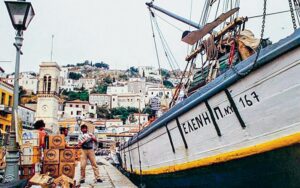
In Greece, the maritime country par excellence, there are still preserved boats built with traditional techniques and of unique value in terms of their cultural and technological characteristics. Shipbuilding was one of the most important economic sectors of the country during the 19th and until the middle of the 20th century. It was one of the country's most important industries in the early twentieth century. Several design features applied to wooden boats were a direct evolution of the corresponding features exhibited by ships in the Aegean in earlier historical periods. The rescue and study of these features undoubtedly helps to clarify the continuity of the maritime and shipbuilding tradition through the centuries. This is perhaps the main reason for the value of salvaging and restoring unique traditional vessels built with pre-industrial techniques that are no longer practiced today.
It is therefore very important to save such Aegean shipwrecks that represent and document the continuity of the Aegean maritime culture of the Greeks. These efforts must be intensified today, as such boats are no longer manufactured and their number is dramatically decreasing year by year. But even in the wooden boats produced today, such as trachantarias, barkalades, liberties, etc., the techniques used are moving further and further away from tradition. First power tools, then imported wood, then digital design and finally automation of production are key elements of modernization applied to the minimal production of today's shipyards, creating a new generation of boats with less and less traditional features.
It is therefore very important to save such Aegean shipwrecks that represent and document the continuity of the Aegean maritime culture of the Greeks. These efforts must be intensified today, as such boats are no longer manufactured and their number is dramatically decreasing year by year. But even in the wooden boats produced today, such as trachantarias, barkalades, liberties, etc., the techniques used are moving further and further away from tradition. First power tools, then imported wood, then digital design and finally automation of production are key elements of modernization applied to the minimal production of today's shipyards, creating a new generation of boats with less and less traditional features.
The project partnership aims to salvage and preserve as many elements of the ship as possible, produce a comprehensive design study for a faithful copy of "Helen P." that includes as many salvaged and preserved elements as possible, produce a digital copy of the restored ship, and produce a study on the use and sustainability of the physical copy of the ship. As a vivid result, "ELENI P." will be made available to the public as a maritime digital exhibit of the Historical Museum of Hydra, a living cultural institution located in the heart of the traditional settlement of the island. The above objectives will be achieved through the preservation, documentation and highlighting of the parts of the boat that can be saved through the comprehensive study on the construction of a physical copy of the boat and through the design and creation of a three-dimensional (3D) digital copy for viewing and highlighting the maritime cultural heritage of Hydra and the Aegean Archipelago in general.
At the same time, the project will make an important contribution to the competitiveness of the economy, since, on the one hand, it will create products and services of a high technological level that can be used in many cases to preserve, promote and save cultural monuments on the domestic market, and, on the other hand, it will contribute significantly to the diversification and export of standard know-how through the new tools and applications that will be developed for the object in question.
The project is expected to represent a significant advance over the "current technological state" of Greek data in the field of diagnosis, maintenance, documentation and highlighting of historical cultural monuments and, in particular, traditional ships, as it will develop new innovative methods, tools and approaches for the protection and rescue of the country's recent cultural heritage and intangible cultural heritage, focusing on traditional ships and traditional shipbuilding. In particular, it is worth highlighting that the project negotiates an innovative approach to the acute problem of the threat of uncontrolled collapse of wooden ships that have not been maintained for many years, despite being designated as monuments. The proposed intervention procedure is in line with the recent Decree No. 63 of Law 4481/2017 for movable monuments, saving as much as possible both the tangible and intangible characteristics of these ships that have made them unique examples of the Greek shipbuilding tradition.


